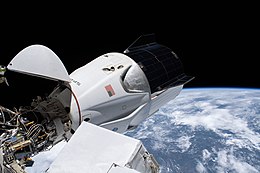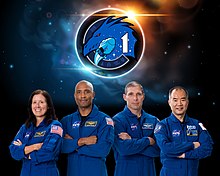
Back سبيس إكس كرو 1 Arabic স্পেস এক্স ক্রু-১ Bengali/Bangla SpaceX Crew-1 Catalan SpaceX Crew-1 Czech SpaceX Crew-1 German SpaceX Crew-1 Spanish SpaceX Crew-1 Estonian اسپیساکس کرو-۱ Persian SpaceX Crew-1 Finnish SpaceX Crew-1 French
 Resilience docked to the International Space Station. | |
| Names |
|
|---|---|
| Mission type | ISS crew transport |
| Operator | SpaceX |
| COSPAR ID | 2020-084A |
| SATCAT no. | 46920 |
| Mission duration | 167 days, 6 hours, 29 minutes, 16 seconds |
| Spacecraft properties | |
| Spacecraft | Crew Dragon Resilience |
| Spacecraft type | Crew Dragon |
| Manufacturer | SpaceX |
| Launch mass | 12,519 kg (27,600 lb) |
| Landing mass | 9,616 kg (21,200 lb) |
| Crew | |
| Crew size | 4 |
| Members | |
| Expedition | Expedition 64 / 65 |
| Start of mission | |
| Launch date | 16 November 2020, 00:27:17 UTC (15 November 7:27:17 pm EST)[1] |
| Rocket | Falcon 9 Block 5 (B1061.1) |
| Launch site | Kennedy, LC‑39A |
| End of mission | |
| Recovered by | MV GO Navigator |
| Landing date | 2 May 2021, 06:56:33 UTC (2:56:33 am EDT) |
| Landing site | Gulf of Mexico, near Panama City, Florida (29°44′50″N 85°59′03″W / 29.747238°N 85.984145°W) |
| Orbital parameters | |
| Reference system | Geocentric orbit |
| Regime | Low Earth orbit |
| Inclination | 51.66° |
| Docking with ISS | |
| Docking port | Harmony forward |
| Docking date | 17 November 2020, 04:01 UTC[2] |
| Undocking date | 5 April 2021, 10:30 UTC |
| Time docked | 139 days, 6 hours, 29 minutes |
| Docking with ISS (relocation)[a] | |
| Docking port | Harmony zenith |
| Docking date | 5 April 2021, 11:08 UTC |
| Undocking date | 2 May 2021, 00:35 UTC[4] |
| Time docked | 26 days, 13 hours, 27 minutes |
 Mission patch[5]  From left: Walker, Glover, Hopkins and Noguchi | |
SpaceX Crew-1 [6][7] (was also known as USCV-1 or simply Crew-1)[8] was the first operational[b] crewed flight of a Crew Dragon spacecraft, and the maiden flight of the Crew Dragon Resilience spacecraft. It was also the second crewed orbital flight launch by the United States since that of STS-135 in July 2011. Resilience launched on 16 November 2020 at 00:27:17 UTC[9][c] on a Falcon 9 from Kennedy Space Center Launch Complex 39A (LC-39A), carrying NASA astronauts Michael Hopkins, Victor Glover and Shannon Walker, along with JAXA astronaut Soichi Noguchi, all members of the Expedition 64 crew.[10][11] The mission was the second overall crewed orbital flight of the Crew Dragon.[12]
Crew-1 was the first operational mission to the International Space Station (ISS) in the Commercial Crew Program. Originally designated "USCV-1" by NASA in 2012, the launch date was delayed several times from the original date of November 2016.[13] The mission was scheduled to depart the ISS on 28 April 2021, but due to weather returned to Earth on 2 May 2021.[14][6][15] The capsule splashed down at 06:56:33 UTC, to be reused on Inspiration4.[16] It was the first nighttime splashdown for NASA astronauts since Apollo 8 in 1968.[17] On 7 February 2021, the Crew-1 broke the record for the longest spaceflight by a U.S. crewed vehicle, surpassing the 84-day mark set by an Apollo capsule on the final flight to the Skylab (Skylab-4) space station on 8 February 1974.[18]
- ^ "Astronauts fly with SpaceX in landmark launch for commercial spaceflight". Spaceflight Now. 16 November 2020. Retrieved 18 November 2020.
- ^ Burghardt, Thomas (17 November 2020). "Crew Dragon Resilience successfully docks, expands ISS crew to seven". NASASpaceFlight.com.
- ^ Potter, Sean (29 March 2021). "NASA TV to Air U.S. Commercial Crew Port Relocation on Space Station" (Press release). NASA. Retrieved 30 March 2021.
 This article incorporates text from this source, which is in the public domain.
This article incorporates text from this source, which is in the public domain.
- ^ "Sunday Splashdown Set for Crew-1 During Light Day on Station". Archived from the original on 19 May 2021. Retrieved 30 April 2021.
 This article incorporates text from this source, which is in the public domain.
This article incorporates text from this source, which is in the public domain.
- ^ "MISSION PATCH: CREW ONE". 21 April 2021. Retrieved 17 May 2021.
- ^ a b Cite error: The named reference
nasapresskitwas invoked but never defined (see the help page). - ^ Cite error: The named reference
nasa20200603was invoked but never defined (see the help page). - ^ Cite error: The named reference
Twit20190412was invoked but never defined (see the help page). - ^ Corbett, Tobias; Barker, Nathan (15 November 2020). "With Resilience, NASA and SpaceX Begin Operational Commercial Crew flights". NASASpaceFlight.com.
- ^ Cite error: The named reference
nasablog20200814was invoked but never defined (see the help page). - ^ Cite error: The named reference
Kitwas invoked but never defined (see the help page). - ^ Cite error: The named reference
nsf20130406was invoked but never defined (see the help page). - ^ "April 2021 – Commercial Crew Program". blogs.nasa.gov. 29 April 2021. Retrieved 29 April 2021.
 This article incorporates text from this source, which is in the public domain.
This article incorporates text from this source, which is in the public domain.
- ^ Heiney, Anna (29 January 2021). "NASA, SpaceX to Launch Second Commercial Crew Rotation Mission to International Space Station". nasa.gov. NASA. Retrieved 29 January 2021.
 This article incorporates text from this source, which is in the public domain.
This article incorporates text from this source, which is in the public domain.
- ^ Cite error: The named reference
sfn_launch-schedulewas invoked but never defined (see the help page). - ^ Chang, Kenneth (2 May 2021). "SpaceX Makes First Nighttime Splash Down With Astronauts Since 1968". The New York Times. Retrieved 2 May 2021.
- ^ "Live coverage: SpaceX crew capsule set to move to new space station docking port". Spaceflight Now. 5 April 2021. Retrieved 5 April 2021.
Cite error: There are <ref group=lower-alpha> tags or {{efn}} templates on this page, but the references will not show without a {{reflist|group=lower-alpha}} template or {{notelist}} template (see the help page).